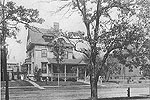|

South Lakefront
(continued)
Hyde
Park-Kenwood
Hyde Park-Kenwood is generally recognized as an island surrounded
by the rest of the South Side. Lying south of 47th Street along
the lakefront to 60thStreet, the Hyde Park-Kenwood Community in
many ways has always been different from nearby areas; although
the distinct flavor of the present-day neighborhood became more
pronounced in the 1950s because of massive urban renewal. Before
that twenty-year process began, the district's boundaries were
more flexible to the north and south. With the changes of the
postwar period, however, Hyde Park's future became different from
that of its surrounding South Side neighbors. In many ways those
changes returned the neighborhood to the pattern that its founder,
Paul Cornell, had intended for it from the beginning.
Dr. John A. Kennicott, a Chicago dentist, moved to the south
suburbs in 1856 and founded Kenwood. Kennicott's estate stood
near the Illinois Central Railroad tracks at 43rd Street. The
name Kenwood is the same as that of his mother's ancestral home
in Scotland. Several other wealthy families moved to Kenwood,
and in 1859 the Illinois Central agreed to make a stop at 47th
Street to serve the new and growing community. By 1875 Kenwood was
the gem of the South Lakefront (See Fig. 1). Stately
homes and mansions were constructed along its tree-lined
streets. Institutional development soon followed. St. Paul's
Episcopal Church and a Congregational church came to the neighborhood.
Some
time later the First Baptist Church moved to 50th Street in the
community. In the 1890s many of Chicago's leading families who
derived their fortunes from meatpacking, steel, and stocks, built
mansions in Kenwood. In the twentieth century such names as Swift,
Rosenwald, and Morris were listed in the social register as Kenwood
residents. With the opening of the Kenwood branch of the "L"
in 1910-the terminus of which was at 42nd and Lake Park Avenue-middle
income families were attracted to the neighborhood, and they
took
up residence in newly constructed apartment buildings. Meanwhile,
the servants in the mansions of Kenwood and middle-class Catholics
who lived north of 47th Street founded St. Ambrose parish in
1904. Later on well-to-do Irish families joined the wealthy
Protestants
in Kenwood and contributed to the growth of St. Ambrose at 47th
and Ellis Avenue.
«
previous
2
of 23
next
»
|
 |

|
 |


Figure 1:
George R.T. Ward Residence, c. 1880. »
|